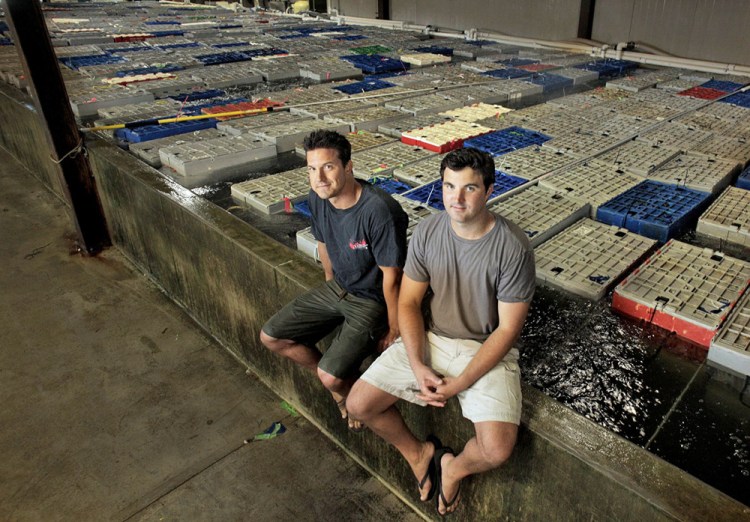Scientists want to know why the number of lobster babies in the Gulf of Maine is declining when their numbers at every other stage of their life cycle remain high.
That question is considered so important to the future of Maine’s $1.5 billion lobster industry that one of Maine’s 200 lobster dealers – Ready Seafood of Portland – is funding a university study to investigate what some scientists call the big disconnect.
“What’s happening to the babies?” asked Brendan Ready. “With all this fishery means to Maine, all the people depending on it, we need to know exactly what’s happening to the babies, exactly what’s going on on the bottom, whether it’s good or bad.”
The babies may be eaten by new predators, like black sea bass, showing up in rapidly warming waters. They may be growing so big during longer summers that scientists mistake fast-growing babies for small-fry juveniles.
Or maybe the Gulf of Maine lobster nursery has gotten bigger, or in this case, deeper.
Two years ago, University of Maine research professor Rick Wahle began sampling to see if the babies are settling in waters deeper than 30 feet, hunkered down in the cobble where scientists never used to look for them because temperatures there used to be too cold.
That would suggest the number of baby lobsters weren’t really declining, or at least as much as inshore suction sampling suggested, but were literally “settling down” into newly suitable habitat where scientists hadn’t been sampling, Wahle said.
The preliminary results from the work were promising, finding what are called the “young of year” lobsters, some as small as a quarter, buried in mesh-lined, rock-filled collectors set in waters as deep as 180 feet in Casco Bay and Down East Maine.
The waters off eastern Maine used to be a “settlement desert,” but no more, Wahle said.
Two years’ worth of data is not enough for scientists to draw any conclusions, however. Surveys of larval, inshore settlement, juvenile, adult and egg-bearing lobsters stretch back decades, and reveal yearly variations that emphasize the need for long-term data collection.
But startup funding for the deep-water sampling project ran out. Maine Sea Grant had awarded Wahle a $150,000 grant to fund the first two years of work to test his theory. He had preliminary results suggesting he was on to something, but didn’t have the funds to prove it.
That is where Ready Seafood comes in. The company’s lobster biologist, Curt Brown, is also an active lobsterman, and had helped Wahle set the Casco Bay collectors in May 2016 and 2017 and retrieve them five months later. He was encouraged by what he saw.
“We know next to nothing about lobster settlement in waters deeper than 30 feet,” Brown said. “I just find that staggering. If you look at the Gulf of Maine, if you look at lobster habitat in general, the majority of where lobsters live is deeper than 30 feet of water.”
At Brown’s urging, Ready Seafood decided to kick in $75,000 a year to continue Wahle’s work.

Rocks from L.P. Murray & Sons in Cape Elizabeth were used to weigh down the deep-water collectors of baby lobster. Research supporters, from left, are Gus Frankwicz, a lobstering apprentice, Curt Brown of Ready Seafood, and from UMaine, Rick Wahle, Carl Huntsberger, Bill Favitta and Abby Shaughnessy. Photo by Michelle Brown, Ready Seafood
In the seafood industry, a lot of lobster dealers and processors fund their own research to boost their profits, said Annie Tselikis, director of the Maine Lobster Dealers Association. Ready is the first Maine dealer she knows that is funding public lobster research.
That kind of private investment is common in Australia and Europe, Tselikis said, but not here.
Ready’s founders, brothers Brendan and John, are both in their 30s, young enough to know the company needs to understand where the fishery is heading if it wants to survive long enough to pass the company down to their young children.
They hired Brown, whom they grew up with in Cape Elizabeth, as the company’s lobster biologist, a position that Tselikis said is unique in the Maine lobster industry. It has worked with UMaine before, helping a student investigate how to speed up lobster shell hardening.
But the decision to fund research that doesn’t directly affect their profit margin, and available to anyone who wants it, including their competitors, is a big step for Ready Seafood, and one that it hopes will inspire other private companies that rely on lobster to do the same.
“We don’t think there’s enough proactive measures being done to invest in the research side,” Brendan Ready said. “The more research, the more collaboration we can do with harvesters, science, and now industry, I think that’s going to distinguish our industry.”
Copy the Story Link
Send questions/comments to the editors.




Success. Please wait for the page to reload. If the page does not reload within 5 seconds, please refresh the page.
Enter your email and password to access comments.
Hi, to comment on stories you must . This profile is in addition to your subscription and website login.
Already have a commenting profile? .
Invalid username/password.
Please check your email to confirm and complete your registration.
Only subscribers are eligible to post comments. Please subscribe or login first for digital access. Here’s why.
Use the form below to reset your password. When you've submitted your account email, we will send an email with a reset code.